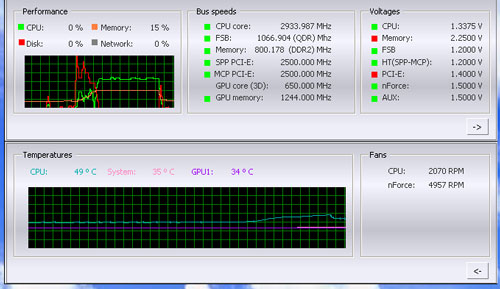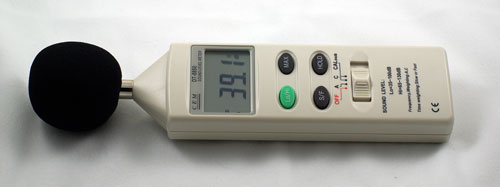The Zalman Twins: 9500 & 9700 Air Tunnels
by Wesley Fink on February 19, 2007 12:40 AM EST- Posted in
- Cases/Cooling/PSUs
CPU Cooling Test Configuration
The standard test bed for cooling tests uses an EVGA NVIDIA 680i SLI motherboard. This is primarily based on the consistent test results on this board and the excellent NVIDIA Monitor temperature measurement utility, which is part of the nTune program.
NVIDIA Monitor has a drop-down pane for temperature measurement which reports CPU, System, and GPU results. Reviews at this point will concentrate primarily on CPU temperature. In addition to the real-time temperature measurement, NVIDIA Monitor also has a logging feature which can record temperature to a file in standard increments (we selected every 4 seconds). This allows recording of temperatures during testing and play back, for example, of stress test results that can then be examined when the stress tests are completed. There is also the handy reference of speeds and voltages in the top pane to confirm the test setup.
Other components in the cooling test bed are generally the same as those used in our motherboard and memory test bed:
| Cooling Performance Test Configuration | |
| Processor | Intel Core 2 Duo X6800 (x2, 2.93GHz, 4MB Unified Cache) |
| RAM | 2x1GB Corsair Dominator PC2-8888 (DDR2-1111) |
| Hard Drive(s) | Hitachi 250GB SATA2 enabled (16MB Buffer) |
| Video Card: | 1 x EVGA 7900GTX - All Standard Tests |
| Platform Drivers: | NVIDIA 9.53 |
| NVIDIA nTune: | 5.05.22.00 (1/16/2007) |
| Video Drivers: | NVIDIA 93.71 |
| CPU Cooling: | Zalman CNPS9700 Zalman CNPS9500 Cooler Master Hyper 6+ Vigor Monsoon II Lite Thermalright MST-9775 Scythe Katana Tuniq Tower 120 Intel Stock HSF for X6800 |
| Power Supply: | OCZ PowerStream 520W |
| Motherboards: | EVGA nForce 680i SLI (NVIDIA 680i) |
| Operating System(s): | Windows XP Professional SP2 |
| BIOS | Award P24 (1/12/2007) |
All cooling tests are run with the components mounted in a standard mid-tower case. The idle and stress temperature tests are run with the case closed and standing as it would in most home setups. We do not use auxiliary fans in the test cooling case, except for the north bridge fan attached to the 680i for overclocking.
We first tested the stock Intel cooler at standard X6800 speed, measuring the CPU temperature at idle and while the CPU was being stressed. We stressed the CPU by running continuous loops of the Far Cry River demo. The same tests were repeated at the highest stable overclock we could achieve with the stock cooler. Stable in this case meant the ability to handle our Far Cry looping for at least 30 minutes.
The same tests were then run on the cooler under test at stock, highest stock cooler OC speed (3.73GHz), and the highest OC that could be achieved in the same setup with the cooler being tested. This allows measurement of the cooling efficiency of the test unit compared to stock and the improvement in overclocking capabilities, if any, from using the test cooler.
Noise Levels

In addition to cooling efficiency and overclocking abilities, users shopping for CPU cooling solutions may also be interested in the noise levels of the cooling devices they are considering. Noise levels are measured with the case open on its side and are measured using a C.E.M. DT-8850 Sound Level meter. This meter allows accurate sound level measurements from 35bdB to 130dB with a resolution of 0.1dB and an accuracy of 1.5dB. This is sufficient for our needs in these tests, as measurement starts at the level of a relatively quiet room. Our own test room, with all computers and fans turned off, has a room noise level of 36.4dB.
Our procedures for measuring cooling system noise are described on page seven along with noise results comparing the stock Intel cooler and recently tested CPU coolers to the Zalman CNPS9500 and CNPS9700 coolers.










50 Comments
View All Comments
Operandi - Friday, February 23, 2007 - link
I think it's your review that missed the mark....Zalman heatsinks have always been designed with low CFM (hence low noise) in mind. Since it appears that you only tested the heatsinks for temperature performance at 12v and nothing else we'll never know how the Zalmans fair against the competition (at least from your tests) with lower fan speeds.
You penalized the Zalmans for being louder then their competitors but everything comes up at 47 dBA anyway indicating your testing environment is louder the heatsinks your testing. If you can't effectively measure the noise level why bother publishing the results?
DrMrLordX - Monday, February 19, 2007 - link
. . . would you be willing to show the test bed a bit more in these articles? It'd be nice to know what kind of airflow environment exists for these coolers during testing. Also, are you planning on doing a roundup with various add-on fans (like the Silverstone FM-121, the 150, 190, and 220 cfm Delta fans, the 102 cfm Sanyo Denki fan, etc)?Wesley Fink - Monday, February 19, 2007 - link
We will try to show more pictures of the test bed in future reviews. The fan roundup is an interesting idea and we will certainly consider doing one.DrMrLordX - Tuesday, February 20, 2007 - link
thanks . . . a fan roundup would help a lot with certain coolers like the Big Typhoon and Ultra-120 that seem to respond well to aftermarket fans. I've heard rumors that the Scythe Infinity can also mount two fans and performs fairly well in such a configuration, though I've only seen one benchmark with a config like that, and the fans were both low-rpm fans.tuteja1986 - Monday, February 19, 2007 - link
Someone beat the Tuniq Tower 120. Need a better aircooler.JarredWalton - Monday, February 19, 2007 - link
Uh... did you even read the article? Because neither of these beats the Tuniq Tower 120... not even close. More expensive, noisier, and lower performance means they lose in all the important areas. The only minor advantage is that they weigh slightly less, but the plastic mounting bracket counteracts that.mostlyprudent - Monday, February 19, 2007 - link
I read his post as an inparative. That is, Anandtech needs to find a better cooler to beet the Tuniq.Sh0ckwave - Wednesday, February 21, 2007 - link
Try the Thermalright Ultra-120 and Scythe Infinity, they might have a chance.fpsdean - Saturday, August 16, 2008 - link
The Thermalright 120 and the Ultra model spanked the Tuniq Tower, as did the Zerotherm NV120.DrMrLordX - Monday, February 19, 2007 - link
He might have been referring to the Monsoon II Lite, but that was reviewed some time ago. Great review though, thanks!